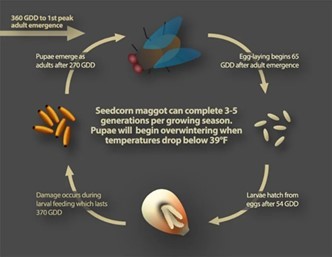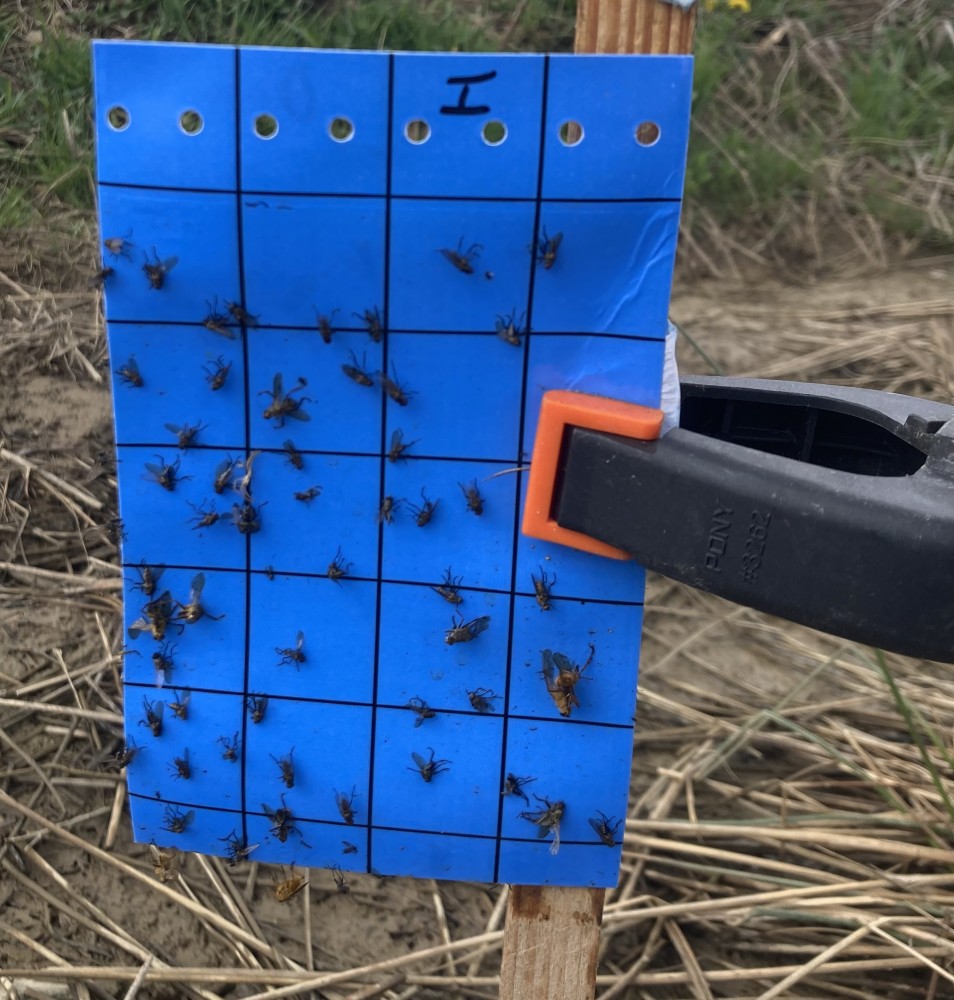Seedcorn Maggot Risk Assessment
Katelyn Miller, Field Crops and Forage Specialist
Southwest New York Dairy, Livestock and Field Crops Program
Seedcorn maggot (SCM) is a pest that was first introduced in the mid-1800s from Europe. Today, it is distributed throughout the United States and southern Canada. This pest impacts large-seeded crops such as corn and soybeans, creating feeding damage to germinating seed.


The seedcorn maggot life cycle begins with the adult fly, which resembles a house fly. The adults lay eggs in the soil early in the spring near food sites or in soil cracks. Because the flies lay eggs in specific locations, fields that are heavily manured or have newly terminated cover crops are favored. The maggots hatch and burrow into the seeds looking for food, creating damage that greatly reduces the chance of a healthy plant emerging, often times killing it. Damage is more severe during cool, wet springs because of delayed seedling emergence. Reduced plant stands will become evident approximately a week after plants begin to emerge.
Unfortunately, there are no rescue treatments for seedcorn maggot. When a field has been severely damaged by the pest, the only option is to replant. This makes preventing infestation the best practice. Partaking in cultural practices like planting when soil and moisture conditions favor quick germination helps to reduce damage to the crop. Management practices revolve around the use of neonicotinoids, which are insecticides chemically related to nicotine. Currently, neonicotinoids are under review for their effects on the environment and pollinators. At this time, seed can still be purchased with the neonicotinoid treatment already applied, but the insecticide has been reclassified as a restricted use pesticide. If you're curious about which products have been re-classified, visit the DEC chemical database, which can be found here:
https://www.dec.ny.gov/chemica....
The New York State Integrated Pest Management (NYSIPM) Program is currently working with NYS Agriculture and Markets to evaluate alternative treatments for this pest. Simultaneously, the Poveda Lab with Cornell University is working on creating a prediction model for the pest that correlates to our Northeast climate. Research is designed to minimize the economic impacts of SCM damage by developing a predictive early season emergence model for the Network for Environment and Weather Application (NEWA) platform, which can be viewed here: https://newa.cornell.edu/. Data is being collected throughout the state for this model, with 9 locations here in Southwest, NY. At each location, there are two sticky traps placed 100 feet apart with a temperature probe. The traps were placed in the first week of April, and will remain until the middle of June, as this is the usual time the pest will attack corn. Every week during this time, the sticky cards are sent in and pest data is correlated to the weather data being collected. Once this research is completed, a new and improved model will be available to producers to help predict SCM emergence!

Upcoming Events
Crops, Cows & Critters - Southwest New York Dairy, Livestock & Field Crops Newsletter Sponsorship
December 19, 2025
Our two forms of publications feature research-based and timely information from our four specialists, listed to the right, along with local event notifications and Cornell University outreach. This information is provided to participants who range from dairy, livestock, and field crops producers to agricultural suppliers and consultants.
Weekly Email Update: Shared with 625+ households who have signed up with our program.
Monthly Paper Mailer: To reach our stakeholders and farmers who lack internet access, we send out a monthly mailer where your company's logo and contact information would be featured with a mailing list of 330+ households.
If you sponsor our weekly and monthly publications you reach approximately 955 households.
Visit our website to view our newsletters!
2025 Cornell Food Beverage & Animal Feed Manufacturer Survey
December 19, 2025
Industry and Educational Advocates for New York State's Food, Beverage, and Animal Feed Manufacturing industries:
As you know, NYS has a diverse food and beverage manufacturing industry, in both the types of industries that exist and the wide distribution of firms by scale. Many manufacturing firms have strong backward linkages to agricultural production sectors in the state that support both farm-level and downstream food industry firms and consumers. In collaboration with the New York State Department of Agriculture and Markets, a team from Cornell University's Charles H. Dyson School of Applied Economics and Management has recently rolled out the 2025 New York State Food, Beverage, and Animal Feed Manufacturer Survey. The industry will benefit from an updated assessment of the industry that informs private and public investments and opportunities to support firm growth and improved profitability.
Cornell Organic Field Crops & Dairy Conference
March 6, 2026
Waterloo, NY
Farmers, researchers, educators, and agricultural service providers from across the Northeast are invited to the 2026 Cornell Organic Field Crops & Dairy Conference, held Friday, March 6, 2026, from 8:00 a.m. to 4:30 p.m. at the Lux Hotel & Conference Center in Waterloo, N.Y.
Co-hosted by New York Soil Health and Cornell CALS, the annual conference brings together leaders in organic grain, dairy, and livestock systems to share practical tools, new research, and farmer-tested strategies to support resilient and profitable organic production.
Announcements
No announcements at this time.





